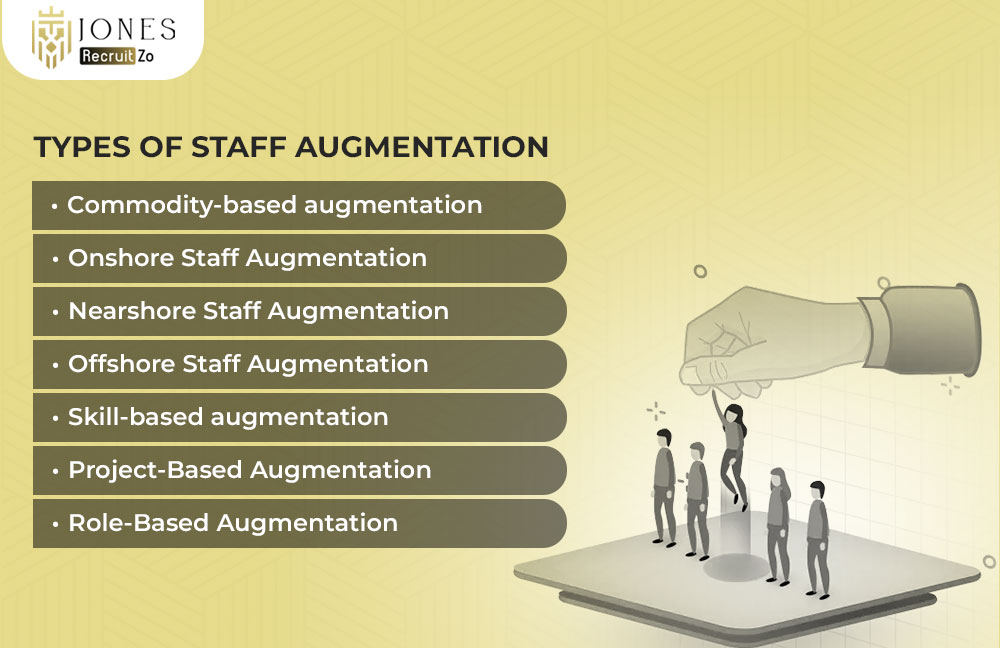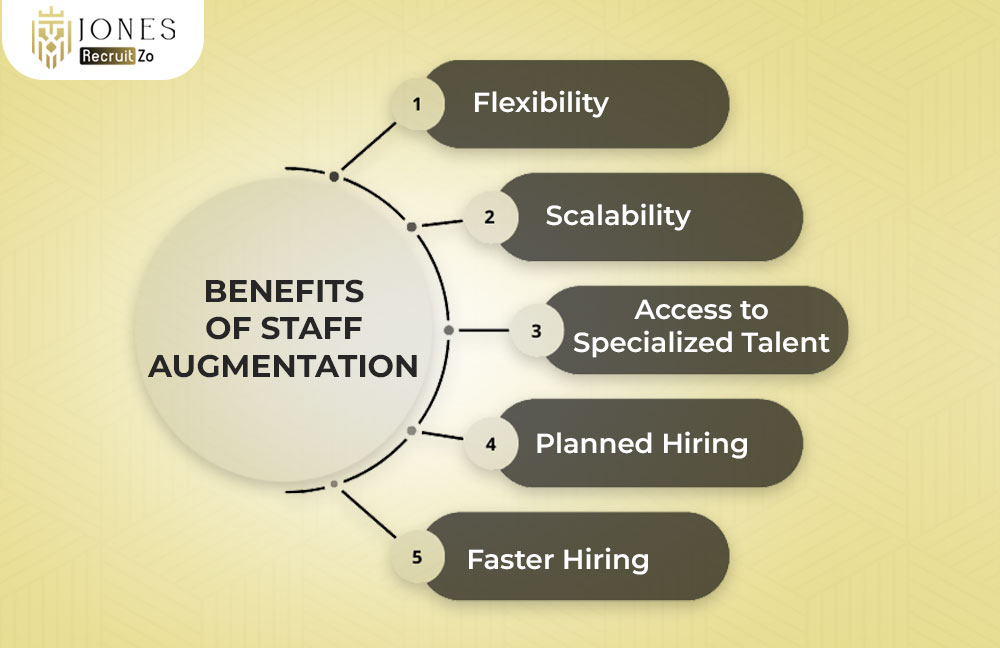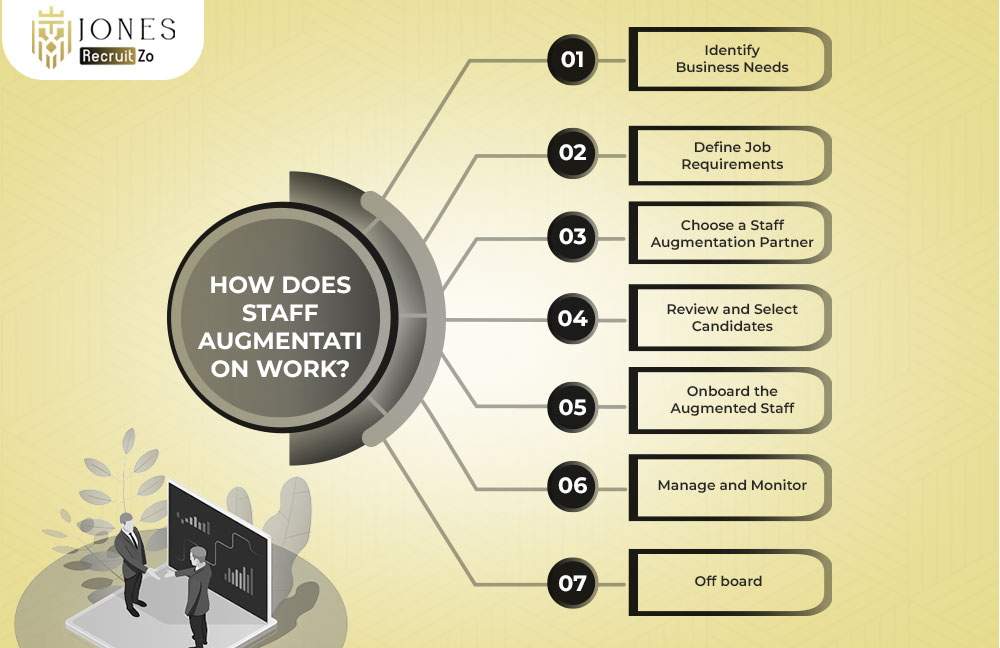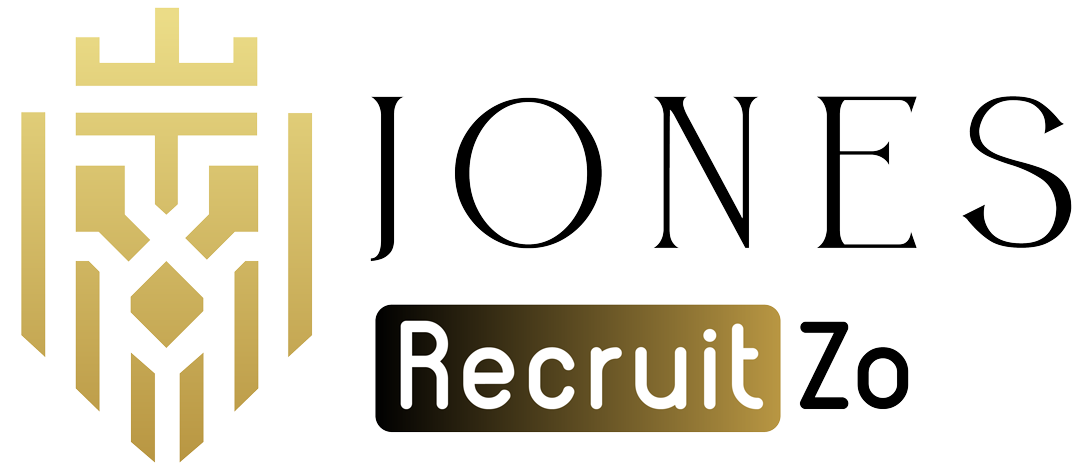What Is Staff Augmentation?
Staff augmentation is an agile workforce approach in which companies hire external professionals on a temporary basis to supplement in-house teams. This allows companies to quickly fill skill gaps, handle workload fluctuations, and expedite project timelines with no long-term commitments involved.
In IT, staff augmentation is widely practised. IT specialists are usually hired under this model to fulfill particular needs of a project, make use of niche skills, or ramp up development efforts.
Types of Staff Augmentation

Understanding the various types of staff augmentation can help organisations choose the model that best fits their needs:
-
Commodity-based augmentation
Hiring people for simple roles that don’t demand any specific skill. This method is mostly appropriate in manual tasks like data entry or manual testing where we mostly require bodies instead of particularised skills.
-
Onshore Staff Augmentation
Onshore augmentation means hiring professionals from outside while staying within the home country. This model allows easier communication and collaboration since the firms share time zones and culture.
-
Nearshore Staff Augmentation
Nearshore augmentation aims at providing talent with a somewhat cheaper option while offering decent collaboration time zone-wise.
-
Offshore Staff Augmentation
Hiring cost-efficient operators from different lands across the molecules has become a common offshore practice. However, their doing sometimes comes with certain challenges, such as time difference and cultural conflict.
-
Skill-based augmentation
Acquisition of experts with particular professional skills is required in this project. So when a project requires expertise that lacks an in-house team, it becomes the best fit.
-
Project-Based Augmentation
That means the company hires outsiders only during the realisation of a certain project. After that, that engagement stops, making their work a very flexible tool for short-term needs.
-
Role-Based Augmentation
Hiring people to fill specific roles in a team, e.g., project managers or UX designers, makes sure all such necessary roles are filled.
Benefits of Staff Augmentation

Staff augmentation offers numerous strategic advantages for businesses of all sizes, especially when faced with evolving project demands and the need for specialized talent.
Flexibility
Staff augmentation allows companies to adjust their staff quickly in alignment with current project requirements. This could be a ramp-up for a massive initiative or downscaling for a few months due to lesser work. Hence, this option provides a flexible way of scaling without the entanglements of long-term contracts.
Scalability
As demands grow, staff augmentation helps grow seamlessly by providing the talent required on demand. Projects will not be held back anymore by staffing issues, and this option allows smooth scaling between departments or regions.
Access to Specialised Talent
The model allows organizations to draw on niche skills and industry expertise unavailable in-house. Whether it’s a cybersecurity analyst or UI/UX designer or a cloud engineer, staff augmentation offers quick access to the right person worldwide, most likely.
Planned Hiring
With staff augmentation, hiring remains strategic and well-planned rather than reactive. You could always bring in experts only when needed–aligning acquiring talent directly with project timelines, milestones, or market demand.
Faster Hiring
Traditional hiring processes tend to take weeks or even months. Staff augmentation quickens the process, as it engages pre-vetted talent pools. The result is a much shorter time-to-productivity, and projects have their rightful start without additional delays.
Differece Between Staff Augmentation vs. Outsourcing
Staff Augmentation
The client company maintains control over the project and integrates outside professionals into its existing teams. This model works well in situations requiring support for particular skills or when capacity needs to be increased temporarily.
Outsourcing
Entire projects or functions are handed over to an external organisation that undertakes the execution independently. This option is best kept for functions that may fall outside the core competencies of the company.
When to Use Staff Augmentation Model?
Staff augmentation is particularly beneficial in the following scenarios:
-
Short-Term Projects
For projects with clearly defined timelines, staff augmentation makes available the needed resources without engaging them in permanent employment.
-
Skill Gaps
External professionals complement internal teams with specific skills, thereby ensuring project success.
-
Seasonal Demand
Businesses encountering seasonal fluctuations can turn to staff augmentation to handle the peak seasons without overstaffing during the off-peak times.
How Does Staff Augmentation Work?

Implementing staff augmentation involves several key steps:
Identify Business Needs
Review your current projects, timelines, and resources. Determine which areas require support and what skills are lacking. This helps define the scope and ensure alignment with your business goals.
Define Job Requirements
Formulate clear job descriptions that detail the duties, qualifications, and experience expected of temporary hires. A well-crafted job description enables your augmentation partner in finding the right candidates faster.
Choose a Staff Augmentation Partner
Choose a reputable and seasoned staffing agency or talent provider. They should employ a broad suite of talent pools and be capable of comprehending your requirements to efficiently recommend the right resources.
Review and Select Candidates
Once candidates are shortlisted, review their profiles, conduct screening interviews if necessary, and assess cultural fit and technical proficiency to ensure smooth integration with your internal staff.
Onboard the Augmented Staff
The augmented personnel need to be trained and given system access with proper introductions to internal tooling, workflows, and teams. Systems for onboarding must be well defined so both internal and external hires can complement each other’s productivity and feel embraced by the organization.
Manage and Monitor
Even though they are temporary hires, managing augmented staff is crucial. Assign clear KPIs, provide regular feedback, and involve them in team meetings to keep them engaged and aligned with project goals.
Off board
At the end of the engagement, conduct a structured offboarding process. This includes collecting feedback, revoking system access, ensuring knowledge transfer to internal teams, and evaluating performance for future opportunities.
FAQs
1) What Is Staff Augmentation?
It is a method where a company hires external workers on a temporary basis to complement their in-house team and cover skill gaps or increased workload.
2) What are the different types of Staff Augmentation?
There are commodity-based, onshore, nearshore, offshore, skill-based, project-based, and role-based augmentations, which respond to specific business needs.
3) How Does Staff Augmentation Work?
Need assessment, defining job requirements, engaging a staff augmentation vendor, candidate selection, onboarding, performance management, and offboarding when the assignment ends.
4) What Is the Difference Between Staff Augmentation and Outsourcing?
In staff augmentation, the outside personnel are incorporated within existing teams and work under the supervision of the company, whereas in outsourcing, the entire project or function is handed to an outside organisation for execution on its own.














